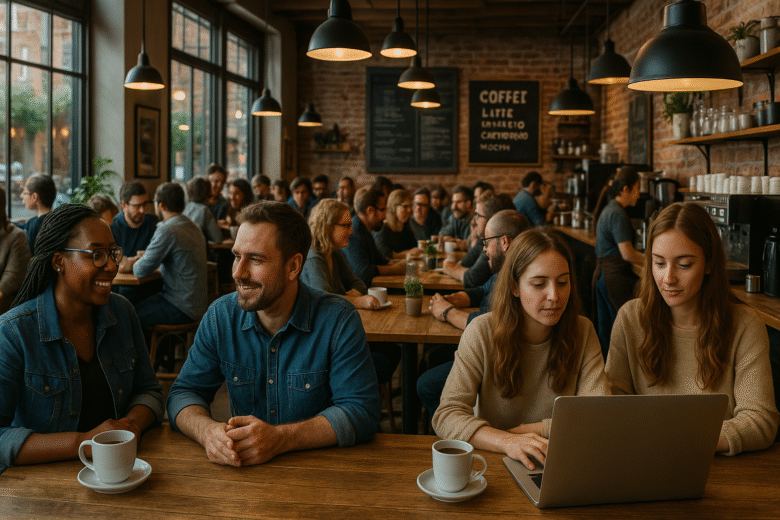Coffee shops have transformed from simple places to get a drink into essential pillars of urban life. They serve as social centers, workspaces, creative hubs, and cultural landmarks.
Their rise is not just about coffee—it’s about connection. In a world that often feels fast and disconnected, coffee shops offer a sense of place and purpose.
The Historical Roots of Social Coffee Spaces
The idea of communal coffee consumption isn’t new. From the 15th-century Arab coffee houses to the 17th-century European cafés, these spaces have always offered more than just caffeine.
Historically, coffee houses were places of discussion, debate, and social interaction. People gathered to talk about politics, literature, and current events.
These venues played major roles in revolutions and cultural movements, fostering ideas that shaped history.
The Coffee Shop as the New “Third Place”
Sociologist Ray Oldenburg coined the term “third place” to describe a space that is neither home (first place) nor work (second place), but where people can build community.
Coffee shops have become the epitome of this idea. They provide a welcoming, neutral ground where people can meet, relax, or work.
With comfortable seating, accessible Wi-Fi, and music in the background, cafés are now destinations for those seeking balance between solitude and connection.
Digital Nomads and the Café Office
In the age of remote work, coffee shops serve a new generation: freelancers, students, and digital nomads who need a flexible workspace.
Many prefer coffee shops over home offices or co-working spaces due to the atmosphere, ambient noise, and stimulation of a public setting.
A good café offers all the essentials: power outlets, reliable internet, and a consistent supply of coffee—all for the price of a latte.
This shift has redefined the role of the coffee shop, making it a cornerstone of modern professional life.
Community and Local Identity
Local coffee shops often reflect the personality and values of their neighborhoods. They support local artists, host community events, and showcase regionally roasted beans.
In gentrifying neighborhoods, cafés can either be forces for inclusion or symbols of change. The most successful ones become trusted spaces that preserve the culture of the area.
By building relationships with regulars and providing more than just a product, these coffee shops foster a sense of belonging.
A Platform for Culture and Creativity
Coffee shops often serve as stages for creative expression. Open mic nights, poetry readings, art exhibitions, and acoustic performances frequently take place within their walls.
The environment encourages conversation, brainstorming, and spontaneous collaboration. For many artists and entrepreneurs, coffee shops are where ideas take shape.
Some cafés even feature rotating art collections, allowing customers to engage with local creativity while enjoying their drink.
Coffee as a Social Catalyst
The act of going for coffee is now a universal social invitation. Whether it’s a first date, a job interview, or a casual catch-up, coffee has become the backdrop.
Its informality makes it approachable. There’s no pressure for a full meal or extended commitment, just the option to connect over a shared ritual.
Even people who don’t drink coffee often find themselves frequenting cafés for the atmosphere and interaction.
The Design of Belonging
The layout and design of modern coffee shops are intentional. Every detail, from lighting to seating arrangement, is chosen to create a mood.
Community tables promote socializing, while cozy corners offer privacy. Music, artwork, and even the scent of coffee all contribute to a space that feels welcoming and safe.
Successful coffee shops blend comfort with style. They’re curated spaces designed to make people want to linger, not rush.
Diversity of Purpose and Audience
Today’s coffee shops cater to a wide range of customers. Parents with strollers, students with laptops, friends chatting, and people reading alone all share the same space.
This diversity of purpose is part of the appeal. Coffee shops are one of the few places where being alone in public is both normal and accepted.
Whether you stay for five minutes or five hours, you belong. That flexibility is rare and valuable in modern society.
Chains vs. Independents: Different Types of Community
While independent coffee shops often focus on local engagement, large chains like Starbucks have mastered consistency and accessibility.
Both play important roles. Chains provide a reliable experience across cities and countries, making them ideal for travelers and those seeking familiarity.
Independents, on the other hand, emphasize uniqueness and personal interaction. Their value lies in originality and connection to the local community.
The Rise of Specialty and Third-Wave Cafés
Specialty coffee shops and third-wave cafés elevate the coffee experience to an art form. Here, coffee is treated like wine—origin, brewing method, and tasting notes matter.
These cafés often employ baristas who are passionate educators, guiding customers through the intricacies of their drink.
This movement has created a deeper relationship between consumers and coffee. It turns a morning routine into a mindful ritual.
Social Media and the Aesthetic Café
Instagram has changed the way people engage with coffee shops. Now, a café’s decor, latte art, and food presentation are as important as the coffee itself.
Visually appealing spaces attract customers who want to share their experience online. This creates free marketing and builds community through digital platforms.
A well-designed coffee shop can become a local landmark simply because it photographs well.
Sustainability and Social Responsibility
Modern consumers care about where their coffee comes from, how it’s brewed, and who benefits from its sale.
Coffee shops are increasingly adopting sustainable practices, from compostable cups to ethical sourcing.
Those that are transparent about their practices build trust and attract a conscious clientele. Environmental and social values are now part of what defines a quality café.
Resilience in Times of Crisis
During global disruptions like the COVID-19 pandemic, coffee shops showed remarkable resilience. Many adapted quickly with takeout windows, delivery options, and outdoor seating.
This adaptability highlighted their importance. When life was uncertain, people still wanted their coffee—and the comfort that came with it.
Post-pandemic, coffee shops are reclaiming their roles as social sanctuaries, more appreciated than ever.
The Future of the Coffee Shop
As society evolves, so will coffee shops. Expect to see more hybrid models combining retail, coworking, and hospitality.
Technological innovations like contactless ordering, coffee robots, and digital loyalty programs will enhance convenience.
Yet the heart of the coffee shop will remain the same—a welcoming space where people come together, find inspiration, and share a moment over a cup of coffee.
Coffee shops are not just about drinks. They are the heartbeat of modern life, offering comfort, connection, and community in a world that sorely needs it.

Marcio Luzardo is a coffee enthusiast and the voice behind Tudo Viraliza. With a passion for turning curiosity into practical knowledge, he shares easy-to-follow tips, guides, and insights to help readers enjoy better coffee every day. When he’s not writing, Marcio is exploring new brewing methods or diving into the rich stories that connect coffee to culture, lifestyle, and wellness.



